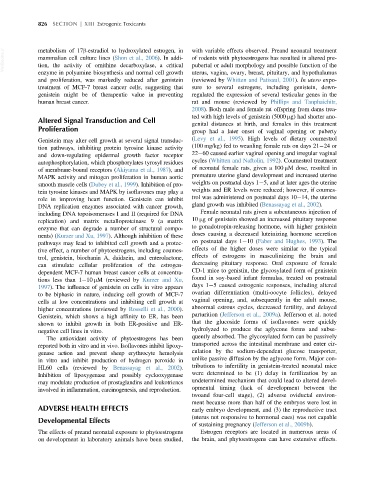Page 868 - Veterinary Toxicology, Basic and Clinical Principles, 3rd Edition
P. 868
826 SECTION | XIII Estrogenic Toxicants
VetBooks.ir metabolism of 17β-estradiol to hydroxylated estrogen, in with variable effects observed. Preand neonatal treatment
of rodents with phytoestrogens has resulted in altered pre-
mammalian cell culture lines (Shon et al., 2006). In addi-
pubertal or adult morphology and possible function of the
tion, the activity of ornithine decarboxylase, a critical
enzyme in polyamine biosynthesis and normal cell growth uterus, vagina, ovary, breast, pituitary, and hypothalamus
and proliferation, was markedly reduced after genistein (reviewed by Whitten and Patisaul, 2001). In utero expo-
treatment of MCF-7 breast cancer cells, suggesting that sure to several estrogens, including genistein, down-
genistein might be of therapeutic value in preventing regulated the expression of several testicular genes in the
human breast cancer. rat and mouse (reviewed by Phillips and Tanphaichitr,
2008). Both male and female rat offspring from dams trea-
ted with high levels of genistein (5000 μg) had shorter ano-
Altered Signal Transduction and Cell
genital distances at birth, and females in this treatment
Proliferation group had a later onset of vaginal opening or puberty
Genistein may alter cell growth at several signal transduc- (Levy et al., 1995). High levels of dietary coumestrol
tion pathways, inhibiting protein tyrosine kinase activity (100 mg/kg) fed to weanling female rats on days 21 24 or
and down-regulating epidermal growth factor receptor 22 60 caused earlier vaginal opening and irregular vaginal
autophosphorylation, which phosphorylates tyrosyl residues cycles (Whitten and Naftolin, 1992). Coumestrol treatment
of membrane-bound receptors (Akiyama et al., 1987), and of neonatal female rats, given a 100 μM dose, resulted in
MAPK activity and mitogen proliferation in human aortic premature uterine gland development and increased uterine
smooth muscle cells (Dubey et al., 1999). Inhibition of pro- weights on postnatal days 1 5, and at later ages the uterine
tein tyrosine kinases and MAPK by isoflavones may play a weights and ER levels were reduced; however, if coumes-
role in improving heart function. Genistein can inhibit trol was administered on postnatal days 10 14, the uterine
DNA replication enzymes associated with cancer growth, gland growth was inhibited (Benassayag et al., 2002).
including DNA topoisomerases I and II (required for DNA Female neonatal rats given a subcutaneous injection of
replication) and matrix metalloproteinase 9 (a matrix 10 μg of genistein showed an increased pituitary response
enzyme that can degrade a number of structural compo- to gonadotropin-releasing hormone, with higher genistein
nents) (Kurzer and Xu, 1997). Although inhibition of these doses causing a decreased luteinizing hormone secretion
pathways may lead to inhibited cell growth and a protec- on postnatal days 1 10 (Faber and Hughes, 1993). The
tive effect, a number of phytoestrogens, including coumes- effects of the higher doses were similar to the typical
trol, genistein, biochanin A, daidzein, and enterolactone, effects of estrogens in masculinizing the brain and
decreasing pituitary response. Oral exposure of female
can stimulate cellular proliferation of the estrogen-
CD-1 mice to genistin, the glycosylated form of genistein
dependent MCF-7 human breast cancer cells at concentra-
found in soy-based infant formulas, treated on postnatal
tions less than 1 10 μM (reviewed by Kurzer and Xu,
days 1 5 caused estrogenic responses, including altered
1997). The influence of genistein on cells in vitro appears
ovarian differentiation (multi-oocyte follicles), delayed
to be biphasic in nature, inducing cell growth of MCF-7
cells at low concentrations and inhibiting cell growth at vaginal opening, and, subsequently in the adult mouse,
higher concentrations (reviewed by Rosselli et al., 2000). abnormal estrous cycles, decreased fertility, and delayed
Genistein, which shows a high affinity to ER, has been parturition (Jefferson et al., 2009a). Jefferson et al. noted
shown to inhibit growth in both ER-positive and ER- that the glucoside forms of isoflavones were quickly
negative cell lines in vitro. hydrolyzed to produce the aglycone forms and subse-
The antioxidant activity of phytoestrogens has been quently absorbed. The glycosylated form can be passively
reported both in vitro and in vivo. Isoflavones inhibit lipoxy- transported across the intestinal membrane and enter cir-
genase action and prevent sheep erythrocyte hemolysis culation by the sodium-dependent glucose transporter,
in vitro and inhibit production of hydrogen peroxide in unlike passive diffusion by the aglycone form. Major con-
HL60 cells (reviewed by Benassayag et al., 2002). tributions to infertility in genistein-treated neonatal mice
Inhibition of lipoxygenase and possibly cyclooxygenase were determined to be (1) delay in fertilization by an
may modulate production of prostaglandins and leukotrienes undetermined mechanism that could lead to altered devel-
involved in inflammation, carcinogenesis, and reproduction. opmental timing (lack of development between the
twoand four-cell stage), (2) adverse oviductal environ-
ment because more than half of the embryos were lost in
ADVERSE HEALTH EFFECTS early embryo development, and (3) the reproductive tract
(uterus not responsive to hormonal cues) was not capable
Developmental Effects
of sustaining pregnancy (Jefferson et al., 2009b).
The effects of preand neonatal exposure to phytoestrogens Estrogen receptors are located in numerous areas of
on development in laboratory animals have been studied, the brain, and phytoestrogens can have extensive effects.

